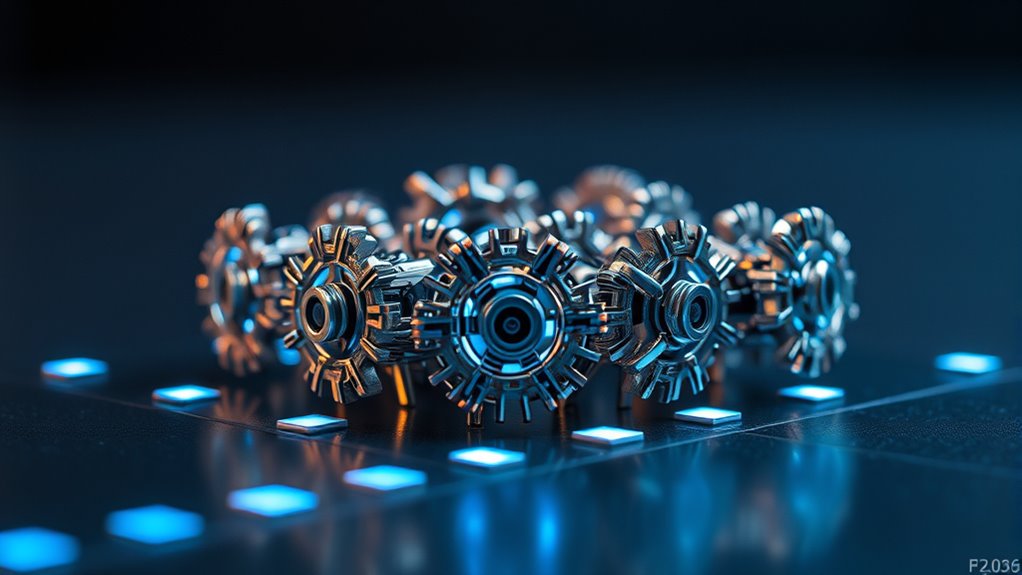Nanomachines are tiny devices that perform precise tasks at the atomic scale, enabling advanced control within robotic and autonomous systems. They include molecular motors, switches, and sensors, made through techniques like electron beam lithography and self-assembly. These machines are used in healthcare for targeted drug delivery and in environmental efforts to detect pollutants. Understanding their design, manufacturing, and integration helps unleash future innovations—continuing will reveal how these microscopic systems will transform technology and society.
Key Takeaways
- Nanomachines serve as core components for precise, responsive control in robotic and autonomous systems at the molecular level.
- Advanced manufacturing techniques like DNA origami and self-assembly enable scalable creation of nanomachines for integration.
- Integration challenges include developing reliable communication, power solutions, and macro-to-nanoscale interfaces for seamless operation.
- Applications encompass targeted drug delivery, environmental sensing, and minimally invasive surgeries enabled by autonomous nanomachines.
- Ethical and safety considerations are crucial for responsible development, ensuring trust, societal acceptance, and regulation of nanomachine-enabled systems.
Fundamentals of Nanomachines and Their Design Principles

Nanomachines are tiny devices built at the molecular or atomic scale, capable of performing specific tasks with high precision. You must understand that their design relies on manipulating individual molecules and atoms to create functional structures. These devices often use components like molecular motors, switches, and sensors to perform actions. Their design principles focus on stability, responsiveness, and energy efficiency, ensuring they operate reliably within complex environments. You need to contemplate how to control interactions at a nanoscale, where quantum effects and thermal fluctuations play significant roles. Simplifying complex biological or chemical functions into manageable nanostructures is essential. Additionally, understanding the fundamental physics involved at the nanoscale is crucial for overcoming challenges related to stability and control. Ultimately, a well-designed nanomachine integrates functionality with minimal energy consumption, enabling precise operations critical for future robotics and autonomous systems.
Manufacturing Techniques for Nanomachines
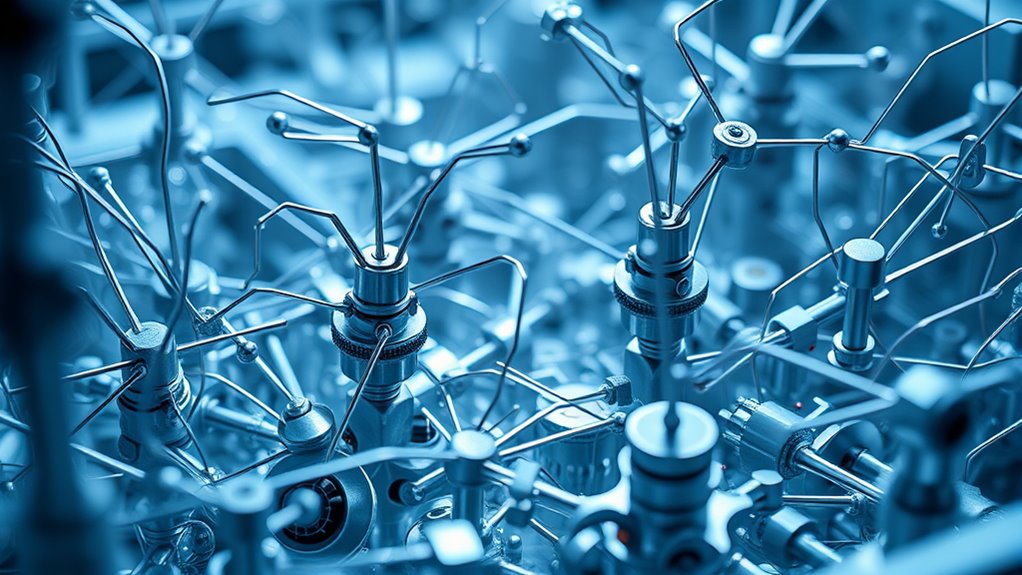
Building nanomachines requires precise manufacturing techniques that enable control at the molecular and atomic levels. Techniques like electron beam lithography allow you to pattern structures with nanometer precision, essential for creating functional components. Chemical vapor deposition helps you grow atomic layers, forming the foundation of nanomaterials. Self-assembly leverages molecules’ natural tendency to organize into desired structures, reducing complexity in fabrication. Atomic force microscopy guides you in manipulating individual atoms and molecules directly. Meanwhile, DNA origami lets you fold DNA strands into specific shapes, serving as scaffolds for nanodevices. These methods push the limits of precision, enabling you to develop complex nanomachines. Understanding bicycle gears and how they operate can provide insights into the control mechanisms at small scales. Mastering these techniques is vital for advancing nanotechnology and integrating nanomachines into future robotics and autonomous systems.
Integration of Nanomachines Into Robotic Systems
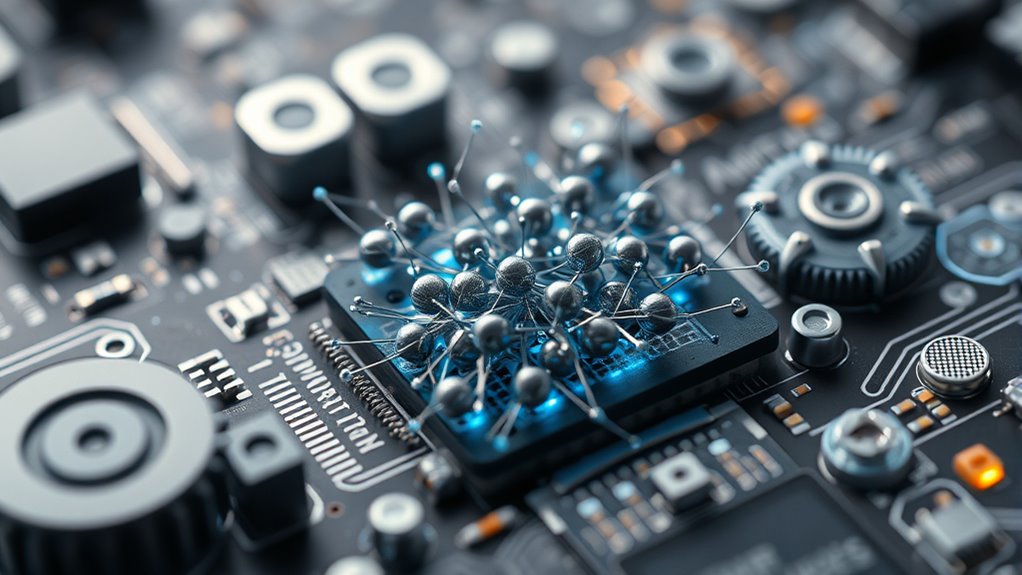
Integrating nanomachines into robotic systems involves overcoming significant challenges related to control, communication, and power management at the nanoscale. To do this effectively, you need to contemplate:
- Precise control mechanisms that allow nanomachines to respond accurately to commands.
- Reliable communication protocols for seamless data transfer between nanomachines and larger systems.
- Efficient power solutions that sustain nanomachine operations without bulky batteries or energy loss.
- Incorporating expert voice actors into communication strategies can enhance clarity and engagement within complex systems.
You’ll work to develop interfaces that translate macro-level commands into nanoscale actions, ensuring synchronization within the system. Overcoming these hurdles will enable nanomachines to perform complex tasks, coordinate with each other, and integrate smoothly into robotic architectures, pushing the boundaries of automation and miniaturization.
Applications in Healthcare and Medical Devices

How can tiny machines revolutionize healthcare and medical devices? Nanomachines can target specific cells or tissues, enabling precise drug delivery that reduces side effects and improves treatment efficacy. They can navigate through bloodstreams, detecting abnormalities like cancerous cells or infections, then responding automatically to deliver medication or perform repairs. These machines can also act as sensors, monitoring critical signs or biochemical markers in real time, providing immediate feedback for better diagnosis. Additionally, nanomachines can help in minimally invasive surgeries, performing tasks at a microscopic level without large incisions. Their ability to operate inside the body with high precision opens new possibilities for personalized medicine and early detection. Furthermore, advances in AI integration are enhancing the capabilities of nanomachines, allowing for smarter, more adaptive responses within biological systems. As a result, healthcare becomes more effective, less invasive, and tailored to individual needs.
Environmental Monitoring and Remediation
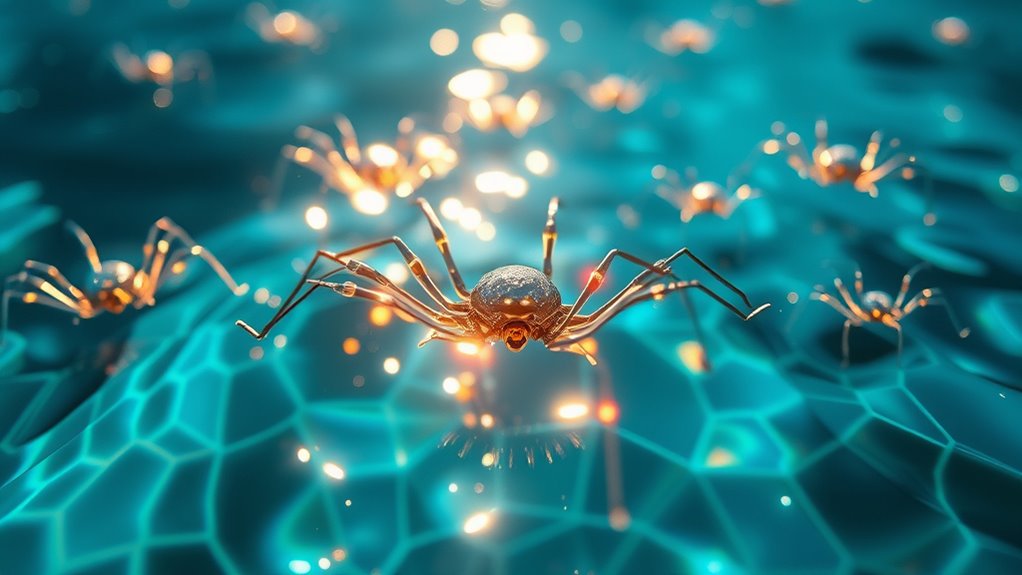
Could tiny machines transform the way you monitor and clean up the environment? These nanomachines can navigate polluted areas, detect contaminants, and initiate cleanup processes. Imagine them performing these tasks:
- Scanning water bodies for toxins like heavy metals or oil spills.
- Identifying airborne pollutants in real-time and signaling for action.
- Breaking down hazardous chemicals into harmless substances on-site.
With their precision, they can access hard-to-reach spots, reducing the need for invasive equipment. You could deploy swarms of nanomachines to continuously monitor ecosystems, providing immediate data and response. This approach offers a fast, efficient, and less disruptive method for environmental remediation, helping restore ecosystems quicker and more effectively. Incorporating nanomachines into environmental management can enhance ecosystem resilience and support biodiversity conservation efforts. Nanomachines could revolutionize environmental management, making cleanup safer and more sustainable.
Challenges in Scaling and Control
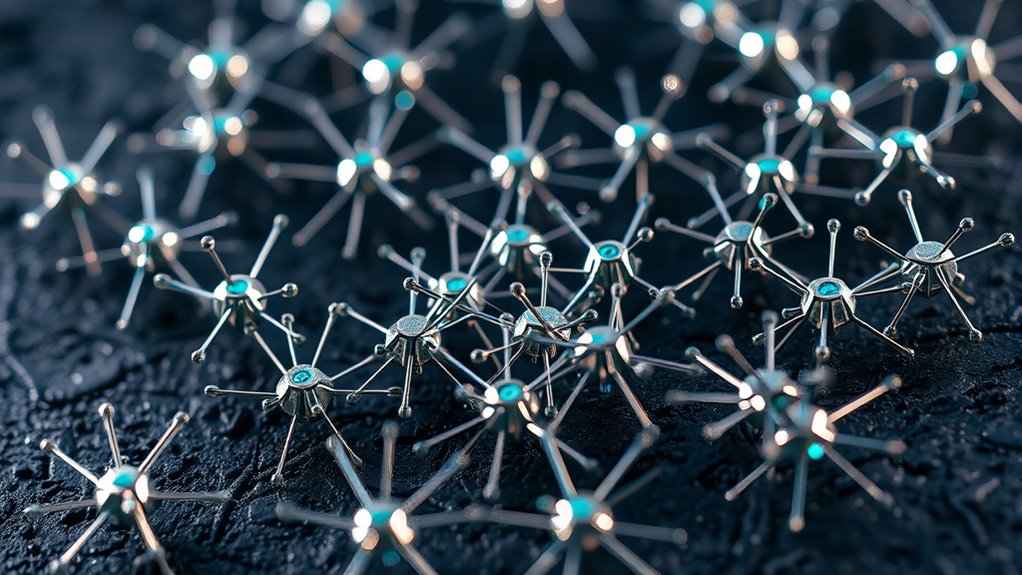
Scaling nanomachines from laboratory prototypes to real-world environmental applications presents significant control challenges. You need precise manipulation at the nanoscale, where traditional methods often fall short. External forces like temperature fluctuations, fluid dynamics, and electromagnetic interference can disrupt nanomachine behavior. Achieving reliable, repeatable control requires sophisticated feedback systems and miniaturized sensors that can operate effectively in complex environments. Additionally, controlling the movement and function of numerous nanomachines simultaneously demands advanced coordination algorithms. These challenges make it difficult to maintain stability and accuracy during deployment. As a result, developing scalable control strategies becomes critical to *unlatching* nanomachines from experimental setups to practical solutions in diverse settings. Addressing these issues is essential for *opening* the full potential of nanotechnology in autonomous systems. Effective control strategies are crucial for overcoming environmental disturbances and ensuring consistent performance at scale.
Future Prospects and Emerging Technologies
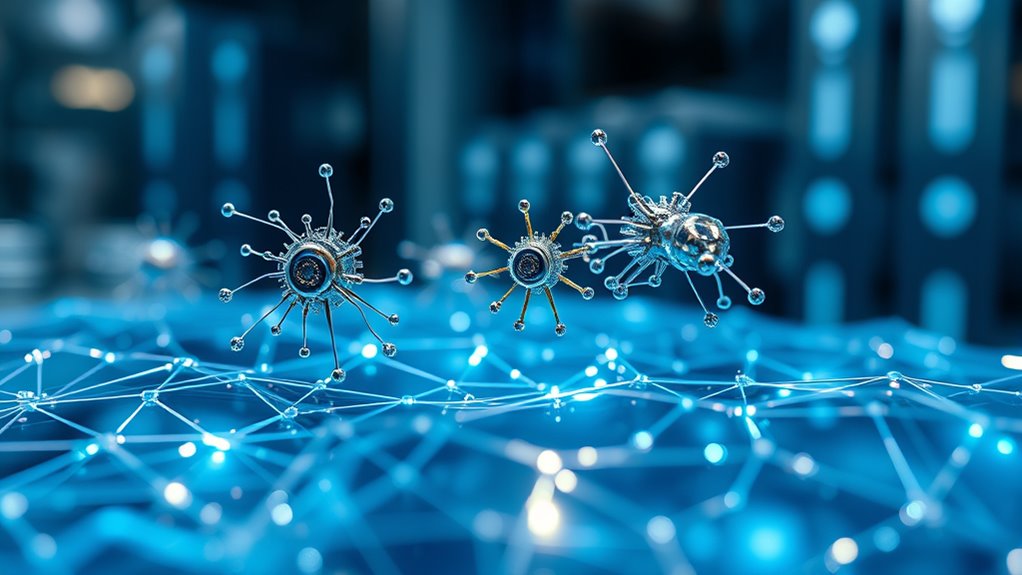
What exciting possibilities lie ahead as nanomachines evolve for robotics and autonomous systems? You can expect groundbreaking innovations that will transform how machines interact with their environment. First, autonomous nanobots could enable precise medical interventions, such as targeted drug delivery or cellular repairs at the molecular level. Second, advancements in self-assembly could lead to dynamic, adaptable structures that reconfigure themselves for different tasks, improving versatility. Third, integration with AI will enhance decision-making, allowing nanomachines to operate independently in complex environments. Additionally, understanding the high resolution capabilities of nanomachines will be essential for achieving these advanced functionalities. These emerging technologies promise to push boundaries, making systems smarter, more efficient, and capable of performing tasks previously thought impossible. As nanomachines develop, your possibilities for innovation and application will expand exponentially.
Ethical Considerations and Safety Implications
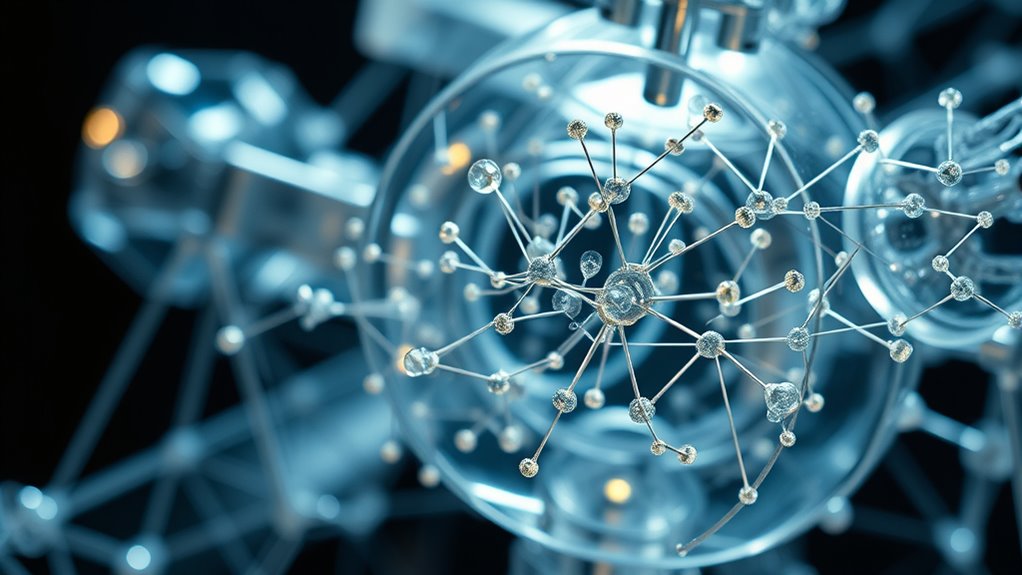
As nanomachines become more integrated into robotics and autonomous systems, addressing ethical considerations and safety implications becomes essential. You must consider potential risks, such as unintended interactions or malfunctions that could cause harm. Privacy concerns also arise if nanomachines collect sensitive data without consent. It’s your responsibility to ensure these technologies are designed with safety protocols and transparency. You should advocate for strict regulations that prevent misuse or malicious applications. Additionally, you need to evaluate the long-term impacts on society, including job displacement and ethical dilemmas surrounding autonomy. Fostering responsible innovation involves balancing technological advancements with thorough risk assessments. By prioritizing safety and ethics, you help build trust and ensure nanomachines serve humanity positively without compromising moral standards. Supporting ongoing research in personal growth can also help professionals develop the ethical awareness needed for responsible innovation.
Frequently Asked Questions
How Do Nanomachines Communicate Within Complex Robotic Systems?
You guarantee nanomachines communicate within complex robotic systems through tiny, energy-efficient signals like electromagnetic waves or chemical exchanges. These signals allow them to coordinate actions, share data, and respond quickly to environmental changes. You program their communication protocols carefully, enabling seamless collaboration. By using advanced nanoscale sensors and controllers, you make certain each nanomachine stays synchronized, maintaining system integrity and optimizing overall performance in your robotic network.
What Are the Energy Sources Powering Nanomachines in Autonomous Applications?
You might be surprised to learn that nanomachines often rely on chemical energy from their environment, such as glucose or other molecules, to power their functions. Studies show that these tiny devices can operate for hours or even days without needing external power sources. You’ll find that some nanomachines harness light or thermal energy, converting it into usable power, allowing them to perform autonomous tasks efficiently within complex systems.
How Do Nanomachines Adapt to Dynamic Environments?
You guarantee nanomachines adapt to dynamic environments by programming them with advanced sensors and smart algorithms. These sensors detect changes in temperature, pH, or chemical signals, allowing nanomachines to respond swiftly. You also incorporate feedback mechanisms that enable real-time adjustments, so they modify their actions based on environmental cues. This adaptability helps nanomachines perform effectively, whether steering through complex biological systems or changing physical conditions.
What Are the Cost Implications of Deploying Nanomachines at Scale?
Deploying nanomachines at scale can be costly, as you need significant investment in research, manufacturing, and maintenance. The initial setup might be expensive, but over time, costs could decrease with technological advances and mass production. However, you should also consider ongoing expenses like energy, monitoring, and potential replacement. Balancing these costs with the benefits requires careful planning to guarantee the investment remains sustainable and effective.
How Is Data Security Maintained in Nanomachine-Enabled Systems?
You safeguard data in nanomachine-enabled systems like a fortress guarding its treasure. Encryption acts as an unbreakable lock, preventing unauthorized access. Regular updates patch vulnerabilities, keeping threats at bay. Authentication verifies users, ensuring only trusted hands handle sensitive information. Monitoring detects suspicious activity, like a vigilant sentinel. By integrating these measures, you create a resilient shield that maintains data integrity and privacy in the face of evolving cyber threats.
Conclusion
Imagine nanomachines as tiny explorers steering the vast, uncharted ocean of technology. Their potential to revolutionize robotics, healthcare, and the environment is immense, but you must tread carefully. By mastering their design, manufacturing, and control, you can harness their power responsibly. Embrace the future with curiosity and caution, ensuring these microscopic explorers open new horizons without steering us into uncharted waters. The journey ahead is yours to shape.
